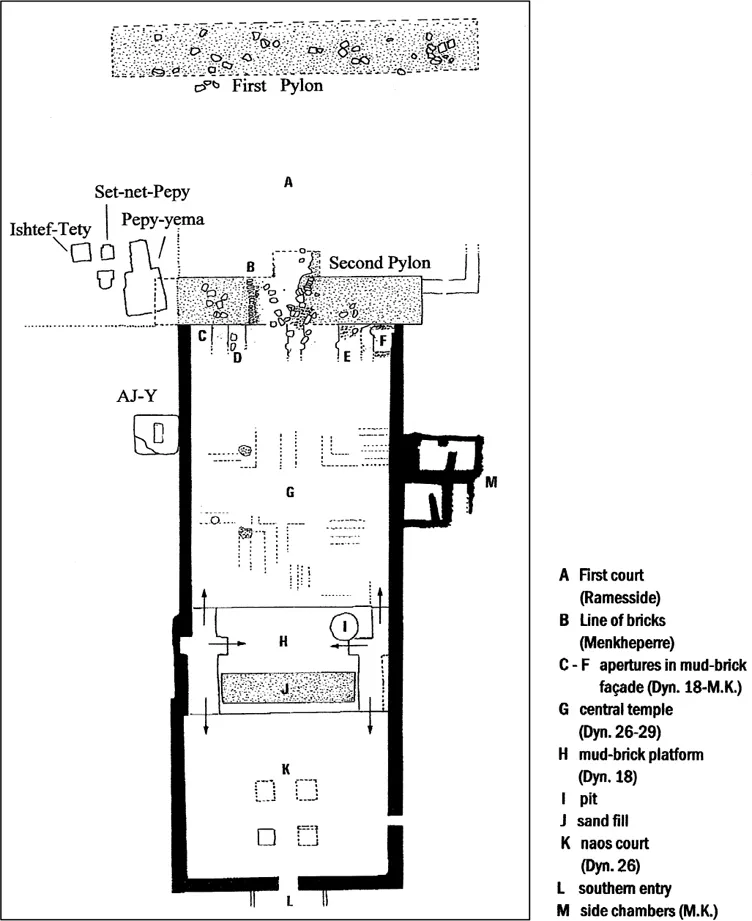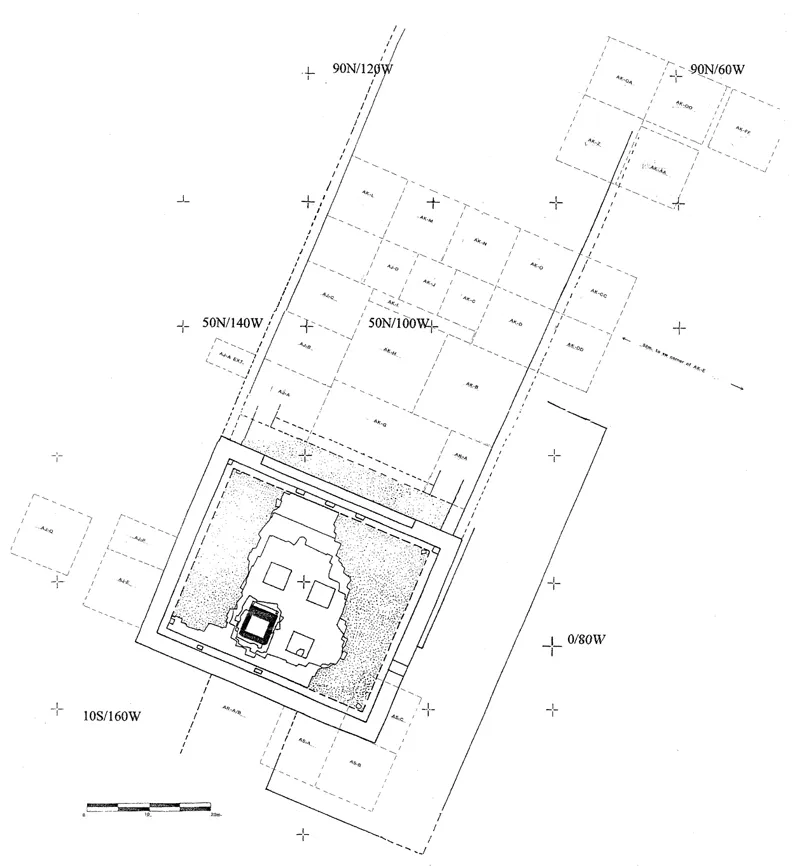
- 216 pages
- English
- ePUB (mobile friendly)
- Available on iOS & Android
eBook - ePub
About this book
Delta Reports is a new series that will make available the substantial amount of archaeological work that has been undertaken in the Delta region of Egypt over recent decades. Volume I contains work done in and around the temple of Ba-neb-djed in the North-west temenos at Tel er-Rub'a (Mendes), material that was previously published in the ATP newsletter by the Akhenaten Temple Project (now discontinued).
Frequently asked questions
Yes, you can cancel anytime from the Subscription tab in your account settings on the Perlego website. Your subscription will stay active until the end of your current billing period. Learn how to cancel your subscription.
At the moment all of our mobile-responsive ePub books are available to download via the app. Most of our PDFs are also available to download and we're working on making the final remaining ones downloadable now. Learn more here.
Perlego offers two plans: Essential and Complete
- Essential is ideal for learners and professionals who enjoy exploring a wide range of subjects. Access the Essential Library with 800,000+ trusted titles and best-sellers across business, personal growth, and the humanities. Includes unlimited reading time and Standard Read Aloud voice.
- Complete: Perfect for advanced learners and researchers needing full, unrestricted access. Unlock 1.4M+ books across hundreds of subjects, including academic and specialized titles. The Complete Plan also includes advanced features like Premium Read Aloud and Research Assistant.
We are an online textbook subscription service, where you can get access to an entire online library for less than the price of a single book per month. With over 1 million books across 1000+ topics, we’ve got you covered! Learn more here.
Look out for the read-aloud symbol on your next book to see if you can listen to it. The read-aloud tool reads text aloud for you, highlighting the text as it is being read. You can pause it, speed it up and slow it down. Learn more here.
Yes! You can use the Perlego app on both iOS or Android devices to read anytime, anywhere — even offline. Perfect for commutes or when you’re on the go.
Please note we cannot support devices running on iOS 13 and Android 7 or earlier. Learn more about using the app.
Please note we cannot support devices running on iOS 13 and Android 7 or earlier. Learn more about using the app.
Yes, you can access Delta Reports by Donald B. Redford in PDF and/or ePUB format, as well as other popular books in History & Egyptian Ancient History. We have over one million books available in our catalogue for you to explore.
Information
1
AN INTERIM REPORT ON THE TEMPLE OF THE RAM-GOD AT MENDES
The early campaigns at Tel er-Rub’a/Mendes,1 from 1992 to 1995, were devoted to the excavation of the royal necropolis in Field AL, due east of the main temple. It was not until 1994 that the decision was taken to transfer our efforts to the elucidation of the Baugeschichte and context of the main temple of the ram-god, Ba-neb-djed. Consequently, between 1995 and the present, all but two seasons were devoted to the main temple area. The first three were conducted under the aegis of the University of Toronto, the remainder under the sponsorship of the Pennsylvania State University. These investigations are ongoing.
The “gazeteer” contained within the stela of Ptolemy II2 reveals the names of a variety of installations of a sacred nature at the site; but the “House of the Ram, Lord of Djedet” can only be identified with the large structure, today a total ruin, lying within the great north-west enclosure. The NNE orientation of this structure (12 degrees off true north) is ancient, probably antedating the Old Kingdom; but the reason for this alignment has yet to be revealed. The temple structure sits upon rising terrain which juts northward into relatively low-lying land, like a peninsula. On the north and west sides this “peninsula” rises nearly two meters above the surrounding flats, and slightly less on the east. This promontory cannot be adequately explained by human occupation-differential, the height and the surrounding flats yielding alike a surface scatter of Late Old Kingdom and First Intermediate Period pottery. It seems more likely that, whatever may have happened at the close of the 6th Dynasty, the difference in elevation was originally occasioned by the sometime presence of water, in the form of either lagoons or water courses, which more or less isolated the terrain on which the original shrine was built.3
THE FIRST PYLON AND FORECOURT
The temple ruins still visible above ground are oriented towards the (local) north and comprise several distinct parts (see plan, Fig. 1). The first, i.e. the northernmost unit, is a court or open space, approximately 35 meters long and 60 meters wide. The floor of the court was presumably of beaten earth, but any remaining surface has disappeared partly through natural erosion and partly through excavation. The side walls of mud-brick have similarly been completely removed, although on the east side the sand foundations could partly be detected. Forming the northern side of the court was a pylon of limestone. Although only about 32 blocks have survived,4 and these wholly disarticulated, the foundation trench filled with fine sand5 is still in evidence. Excavations revealed the following over all dimensions of the pylon: each massif 28.5 meters long and approximately 6–8 meters wide, with a gate in the center 3–4 meters wide. These dimensions fall only slightly short of those of the Luxor pylon, although the first court at Mendes is considerably smaller than its Luxor counterpart. The pylon sits somewhat precariously on the northern edge of the “peninsula” described above, and two meters above the depression to the north; yet it obviously survived into the Middle Ages.6
The date of the pylon would have been difficult to ascertain archaeologically. We attempted to retrieve a foundation deposit in the east wing, but found that everywhere, east and west, the sand-fill had been churned up. Sections revealed pits and declivities in the sand, back-filled with limestone chips, where robbers had removed blocks for the lime kilns (Pl. 1). More modern diggers had also been present: pieces of modern glass and about a dozen bullets were found in the fill, along with two newspaper fragments, one dated to 1946, the other (French) with no date, but mentioning Sir Reginald Oakes. While the former puts one in mind of Labib Habachi’s work at the site in the postwar years,7 the latter must attest the presence of Naville in the late 19th century.
Two items of inscriptional evidence helped to clinch the date of the first pylon. One was a limestone block, long known,8 lying today about 10 meters inside the pylon gate. It bears two horizontal bands of text with parts of the cartouches of Ramesses II and Merenptah. The whole resembles similar bands inscribed at the base of reveals of pylon doors at other sites, and dating from the same two reigns.9 In the present case the block must originally have stood on the east side of the pylon gateway. A second inscription (Pl. 2) was uncovered in the 1994 campaign on a block from the east wing of the pylon. Here a horizontal band of text reads Mr.n-[pt]ḥ. Although additional fragments of limestone have turned up in the foundation sand, some painted, no further clue was recovered as to how the facade of the pylon had been decorated. But that it was the work of the 19th Dynasty cannot now be denied.

FIG. 1. Plan of the temple of Ba-neb-djed, Tel er-Rub’a, showing distribution of identified pylons, rooms and other components, as of summer, 2005.

FIG. 2. Plan of the temple of Banebdjed currently under excavation, showing distr...
Table of contents
- Cover
- Title Page
- Copyright
- Contents
- Preface
- Chapter 1: An Interim Report on the Temple of the Ram-God at Mendes
- Chapter 2: Two Late Roman Amphorae from Mendes
- Chapter 3: Numismatic Report
- Chapter 4: Late New Kingdom Ceramics at Mendes
- Chapter 5: An Interim Report on the Naqada III – First Intermediate Period Stratification at Mendes 1999–2005